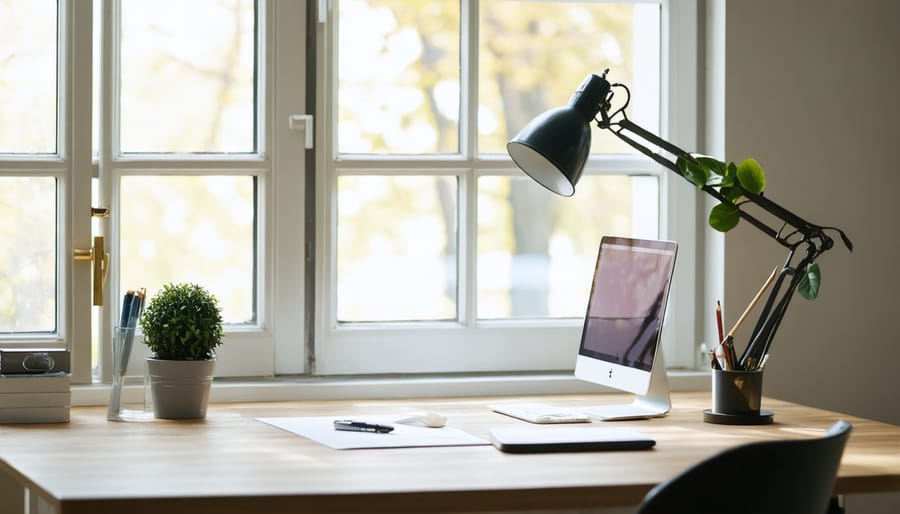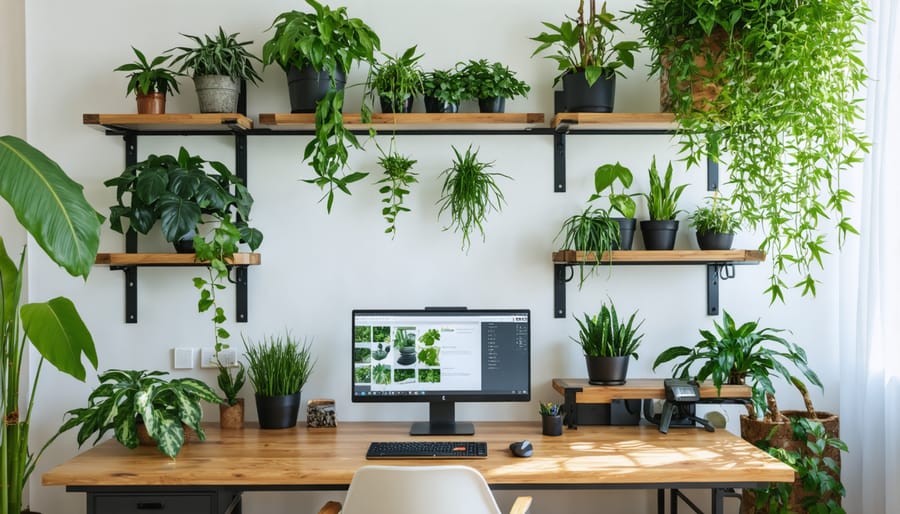Transform your home office into a serene sanctuary by combining minimalist design principles with strategic organization. Clear your desk of all non-essential items, keeping only daily tools within arm’s reach to boost your productivity. Position your desk near natural light and incorporate living plants like peace lilies or bamboo to purify the air and create a natural flow of energy. Choose a neutral color palette dominated by whites, soft grays, and natural wood tones to maintain visual calm, while adding textural elements like a woven rug or linen curtains for warmth. Install adjustable, warm lighting fixtures to maintain consistent illumination throughout the day, reducing eye strain and maintaining focus. Select furniture with clean lines and hidden storage solutions to maintain an uncluttered environment that promotes mental clarity and creative thinking.
The Foundation of a Zen Home Office
Minimalism and Decluttering
The foundation of a zen home office lies in embracing minimalism and maintaining a clutter-free environment. Start by adopting the “less is more” principle – keep only what you genuinely need and use regularly. Organize your desk with just the essential items: a laptop, a notebook, and perhaps a few carefully chosen decorative elements.
Implement the “one in, one out” rule to prevent accumulation – whenever you bring a new item into your office, remove something else. Create dedicated storage solutions for paperwork and supplies, using drawer organizers and filing systems that keep everything out of sight but easily accessible.
Digital decluttering is equally important. Organize your computer files into clear folders, maintain a clean desktop, and regularly archive or delete unnecessary documents. Consider going paperless where possible to reduce physical clutter.
Choose furniture with clean lines and simple designs that serve multiple purposes. A desk with built-in storage or floating shelves can maximize space while maintaining minimalist aesthetics. Remember, each item in your office should either serve a practical purpose or bring you joy – anything else is just creating visual noise that can disrupt your zen atmosphere.

Natural Light and Air Flow
Natural light is a cornerstone of zen design, and incorporating it into your home office can dramatically enhance your workspace’s tranquility and productivity. Position your desk near a window to maximize daylight exposure, which not only reduces eye strain but also helps maintain your natural circadian rhythm. If possible, opt for sheer curtains or adjustable blinds that allow you to control light levels throughout the day.
Creating proper airflow is equally important for maintaining a balanced workspace. Consider keeping windows open when weather permits, and position your furniture to allow air to circulate freely throughout the room. A small desktop plant can help purify the air while adding a touch of nature to your space. If natural ventilation is limited, consider investing in a compact air purifier or a small desktop fan to keep the air moving.
For rooms with limited natural light, strategically placed mirrors can help reflect and amplify available daylight. Position them opposite windows to bounce light deeper into your space. Remember, a well-ventilated and naturally lit office not only promotes better focus but also creates a more sustainable and energy-efficient workspace.

Calming Color Schemes and Materials
Nature-Inspired Color Palettes
Drawing inspiration from nature’s calming elements can help create the perfect zen workspace through thoughtful mood-enhancing color schemes. Start with a foundation of earthy neutrals like warm stone gray or soft sand beige to ground your space. These colors work wonderfully as base tones for walls and larger furniture pieces.
Consider incorporating sage green, which studies show can enhance focus while reducing eye strain. This versatile color pairs beautifully with natural wood tones and can be used for accent walls or through plants and accessories. Soft blues reminiscent of clear skies and gentle waters help promote tranquility and clear thinking – perfect for areas where you need to concentrate.
For a touch of warmth, introduce muted terracotta or gentle coral tones through decorative elements. These nature-inspired hues can energize your space without being overstimulating. Keep the overall palette limited to 3-4 colors to maintain that sense of calm and avoid visual clutter.
Remember to balance your chosen colors with plenty of white space, allowing each shade to breathe. This creates a harmonious environment that supports both productivity and peace of mind, essential elements of any zen home office.
Natural and Sustainable Materials
Natural materials are essential for creating a truly zen home office, as they help forge a deeper connection with nature and promote a sense of calm. Wood is particularly effective, with its warm tones and organic patterns bringing a grounding element to your workspace. Consider a solid wood desk or floating shelves made from reclaimed timber to add character while staying environmentally conscious.
Bamboo is another excellent choice, offering both sustainability and style. Its rapid growth rate makes it one of the most eco-friendly materials available, and its light color naturally brightens your space. Try incorporating bamboo desk organizers, window blinds, or even a bamboo chair mat to bring this versatile material into your office.
Don’t stop at furniture – introduce other natural elements like cotton or linen curtains, wool rugs, and stone accessories. A collection of smooth river rocks can serve as paperweights while adding visual interest, while a cork bulletin board provides both functionality and natural texture.
When selecting these materials, opt for items with minimal processing and natural finishes. This not only maintains their authentic appearance but also reduces your exposure to artificial chemicals, creating a healthier work environment. Remember, the goal is to create a space that feels connected to nature while maintaining professional functionality.
Furniture and Layout Optimization
Ergonomic Essentials
Creating a peaceful workspace starts with choosing furniture that supports both your body and your productivity. Your ergonomic desk setup is the foundation of a comfortable workday, so invest in pieces that promote good posture and reduce physical strain.
Start with a height-adjustable chair that provides proper lumbar support and allows your feet to rest flat on the floor. Look for chairs with adjustable armrests and seat depth to accommodate your unique body proportions. Your desk should be at a height where your elbows naturally rest at 90 degrees when typing.
Consider a standing desk or desk converter to give yourself the flexibility to change positions throughout the day. This movement helps maintain energy levels and reduces the negative effects of prolonged sitting. Add a monitor stand or arm to position your screen at eye level, preventing neck strain.
Don’t forget the smaller details that make a big difference. A keyboard tray can help maintain proper wrist positioning, while an anti-fatigue mat provides comfort when standing. A footrest can improve circulation and posture when seated for extended periods.
Remember, comfort doesn’t mean sacrificing style. Many ergonomic furniture pieces now come in sleek, minimalist designs that perfectly complement a zen aesthetic. Choose pieces in natural materials and neutral colors to maintain your space’s peaceful atmosphere while supporting your body’s needs.
Strategic Space Planning
The art of arranging your home office using feng shui principles can transform your workspace into a haven of productivity and peace. Start by positioning your desk in the “command position” – where you can see the door while seated but aren’t directly in line with it. This placement creates a sense of security and control over your environment.
Create clear pathways around your furniture to allow energy (chi) to flow freely throughout the space. Avoid placing your desk directly against a wall if possible; instead, leave a small gap to promote better energy circulation. If you must face a wall, hang inspiring artwork or a mirror to expand the visual space.
Balance the five elements of feng shui in your furniture choices. Incorporate wood elements through your desk and shelving, metal through lighting fixtures or accessories, and earth tones in your color scheme. Keep water elements (like a small fountain) in the north area of your office to enhance career success, and add fire elements (like warm lighting or red accents) in the south to boost recognition and reputation.
Consider the bagua map when arranging storage solutions. Place knowledge-related items in the northeast sector, career items in the north, and helpful people connections in the northwest. Keep your workspace clutter-free by incorporating smart storage solutions that maintain clean lines and open space, essential for maintaining zen-like tranquility.
Mindful Accessories and Organization
Biophilic Elements
Bringing nature into your workspace is one of the most effective ways to create a peaceful atmosphere and reduce stress. Start by incorporating low-maintenance indoor plants like snake plants, peace lilies, or bamboo, which not only purify the air but also add a touch of serenity to your space.
Position your desk near a window to maximize natural light and create a connection with the outdoors. If natural light is limited, consider using full-spectrum light bulbs that mimic sunlight. Add natural materials like wood, stone, or bamboo through furniture pieces and decorative elements to enhance the biophilic feel.
A small desktop fountain can introduce the soothing sound of flowing water, while natural textiles like cotton or linen curtains add organic texture. Consider displaying crystals, river rocks, or driftwood as decorative elements that bring earth energy into your space.
Don’t overlook the power of natural scents – essential oil diffusers with calming fragrances like lavender, eucalyptus, or cedar can transform your office into a tranquil sanctuary. Remember to keep your plant arrangements simple and uncluttered, following the zen principle of minimalism. Even a single, well-placed succulent can make a significant impact on your workspace’s atmosphere.

Smart Storage Solutions
Nothing disrupts zen quite like visual clutter and tangled cables. Smart storage solutions are essential for maintaining a peaceful home office environment, and the key lies in making everything accessible yet invisible. Start by investing in furniture pieces that do double duty – an ottoman with hidden storage space can keep extra supplies within arm’s reach, while a desk with built-in cable management keeps technology organized.
Consider installing floating shelves with hidden brackets for a clean, minimalist look. These can house decorative boxes and baskets that conceal office essentials while maintaining the room’s serene aesthetic. For paperwork and documents, opt for vertical file organizers that can be tucked away in closets or mounted inside cabinet doors.
Cable management is crucial for maintaining tranquility. Use cable clips or sleeves to guide wires along the back of your desk, and invest in a cable management box to hide power strips and adapters. Consider drilling small holes in your desk for cables to pass through, creating a cleaner workspace. Wireless peripherals like keyboards and mice can significantly reduce cable clutter.
Make use of wall space with modular organization systems that can be adjusted as your needs change. Magnetic strips hidden behind artwork can store small metal items, while pegboards painted to match your walls provide flexible storage without visual overwhelm. Remember, the goal is to create a space where everything has its place, but that place doesn’t have to be visible.
Creating Your Daily Zen Routine
Creating a daily zen routine is essential for maintaining the peaceful atmosphere of your home office. Start each workday by taking a few minutes to declutter your desk, removing any items that accumulated from the previous day. This simple act helps clear both your physical space and mental state.
Incorporate mindful morning rituals before diving into work. Open your windows for fresh air circulation, water any office plants, and perhaps light a subtle natural incense or essential oil diffuser. These small actions signal to your brain that it’s time to transition into your workspace with intention.
Throughout the day, practice the “5-minute reset” technique: Every two hours, pause to straighten your desk, adjust your posture, and take several deep breaths. This helps maintain both the physical order of your space and your mental clarity.
End each workday with a closing ritual. Organize your materials for tomorrow, clean your desk surface, and store away any electronics or papers that might tempt you to work after hours. Consider keeping a small journal to jot down any remaining thoughts or to-dos, allowing you to truly disconnect from work mode.
Remember to maintain your zen elements regularly. Dust your bamboo plants weekly, wash any meditation cushions monthly, and replace air-purifying filters as needed. Keep cleaning supplies within easy reach but hidden from view to encourage regular maintenance without disrupting the aesthetic.
By following these daily practices, your zen home office won’t just look peaceful – it will consistently feel like the calming sanctuary you’ve designed it to be.
Creating a zen home office is more than just a design choice – it’s an investment in your wellbeing and productivity. By incorporating the principles we’ve discussed, from minimalist furniture arrangements to natural elements and proper lighting, you can transform your workspace into a sanctuary of calm and focus.
Remember that achieving a zen atmosphere doesn’t require a complete office overhaul or expensive renovations. Start small by decluttering your space, adding a few plants, or repositioning your desk to maximize natural light. As you become more comfortable with these changes, gradually implement other elements that resonate with your personal style and work needs.
The key is to maintain balance in both design and functionality. Regular tidying, mindful decoration choices, and conscious effort to keep technology organized will help preserve the peaceful atmosphere you’ve created. Let your zen office evolve with you, making adjustments as your needs change.
Take the first step today – even small changes can lead to significant improvements in your work environment and overall mindset. Your perfect zen home office awaits!
